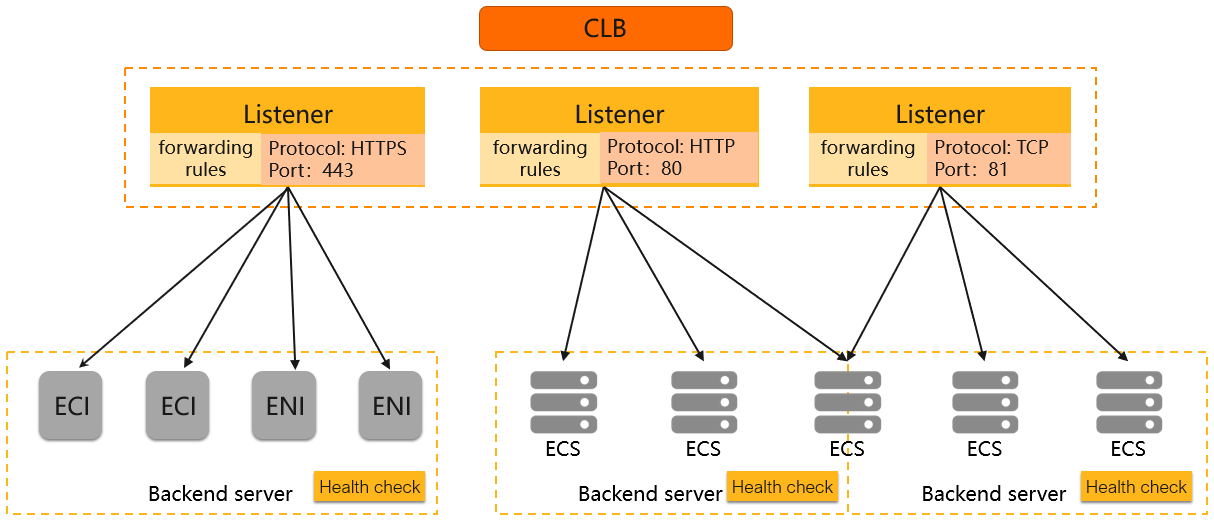Classic Load Balancer (CLB) improves the throughput of applications by distributing requests to different backend servers. CLB can also improve the availability of applications because it can prevent single points of failure (SPOFs). To use CLB, you must create a CLB instance and add listeners and backend servers to the CLB instance. Alibaba Cloud provides Internet-facing and internal-facing CLB instances. If you choose the pay-by-specification metering method, high-performance instances and shared-resource instances are supported.

Instance types
Alibaba Cloud provides Internet-facing and internal-facing CLB instances.
Internet-facing CLB instances
When you create an Internet-facing CLB instance, it is assigned a public IP address. You can associate your domain name with the public IP address. Internet-facing CLB instances receive requests from clients over the Internet and forward requests to backend servers based on the forwarding rules that you configure for listeners.
Internet-facing CLB instances have the following features:
Each Internet-facing CLB instance is assigned a public IP address. You cannot disassociate the public IP address from the CLB instance.
Pay-as-you-go CLB instances support the pay-by-bandwidth and pay-by-data-transfer metering methods.
Internal-facing CLB instances
Internal-facing CLB instances provide external services by using private IP addresses. Requests from the internal network of Alibaba Cloud are distributed to backend servers based on the forwarding rules that you configure for listeners.
You can associate elastic IP addresses (EIPs) with internal-facing CLB instances to provide Internet-facing services. Internal-facing CLB instances provide the following capabilities to support Internet access:
You can associate EIPs with internal-facing CLB instances and disassociate EIPs from internal-facing CLB instances based on your business requirements.
You can add EIPs to an Internet Shared Bandwidth instance to reduce Internet costs.
The network types supported by an internal-facing CLB instance vary based on the billing method of the CLB instance.
Pay-as-you-go internal-facing CLB instances support only VPCs.
If the network type of an internal-facing CLB instance is VPC, the private IP address of the CLB instance is assigned from the CIDR block of a vSwitch in the VPC specified by you. The CLB instance is accessible only from Elastic Compute Service (ECS) instances in the VPC.
Instance specifications
Only the pay-by-specification metering method supports high-performance CLB instances and shared-resource CLB instances.
High-performance CLB instances
The following section describes three key metrics of high-performance CLB instances:
Maximum number of connections
The maximum number of concurrent connections that a CLB instance supports. If the number of existing concurrent connections reaches the upper limit, new connection requests are dropped.
Connections per second (CPS)
The number of new connections that can be established per second. If CPS reaches the upper limit, new connection requests are dropped.
Queries per second (QPS)
The number of HTTP or HTTPS queries (requests) that can be processed per second. This metric is specific to Layer 7 listeners. If QPS reaches the upper limit, new connection requests are dropped.
| Specification | Maximum number of connections | CPS | QPS |
| Small I (slb.s1.small) | 5,000 | 3,000 | 1,000 |
| Medium I (slb.s2.small) | 50,000 | 5,000 | 5,000 |
| Medium II (slb.s2.medium) | 100,000 | 10,000 | 10,000 |
| Large I (slb.s3.small) | 200,000 | 20,000 | 20,000 |
| Large II (slb.s3.medium) | 500,000 | 50,000 | 30,000 |
| Super Large I (slb.s3.large) | 1,000,000 | 100,000 | 50,000 |
The maximum capacity of a pay-as-you-go CLB instance is the same as the capacity of a Super Large I (slb.s3.large) CLB instance.
Shared-resource CLB instances
Resources are shared among all shared-resource CLB instances. Therefore, the performance of shared-resource CLB instances is not guaranteed.
Shared-resource CLB instances are no longer available for purchase.
Differences between shared-resource and high-performance CLB instances
Item | High-performance CLB instance | Shared-resource CLB instance |
Resource allocation | Exclusive resources | Shared resources |
Service uptime guaranteed by the service-level agreement (SLA) | 99.95% | Not supported |
IPv6 | ✓ | - |
Server Name Indication (SNI) for multiple certificates | ✓ | - |
Blacklists and whitelists | ✓ | - |
Association with elastic network interfaces (ENIs) | ✓ | - |
Adding backend servers by specifying the secondary IP addresses of ENIs that are attached to Elastic Compute Service (ECS) instances | ✓ | - |
HTTP-to-HTTPS redirection | ✓ | - |
Consistent hashing | ✓ | - |
TLS security policies | ✓ | - |
HTTP2 | ✓ | - |
WebSocket or WebSocket Secure | ✓ | - |
In the preceding table, a check mark (√) indicates that the feature is supported, and a hyphen (-) indicates that the feature is not supported.
References
If you require more concurrent connections at Layer 4, use Network Load Balancer (NLB). If you require a higher queries per second (QPS) value at Layer 7, use Application Load Balancer (ALB).
For more information about NLB, see What is NLB?
For more information about ALB, see What is ALB?
For more information about how to select the specification of a high-performance CLB instance, see FAQ about CLB.